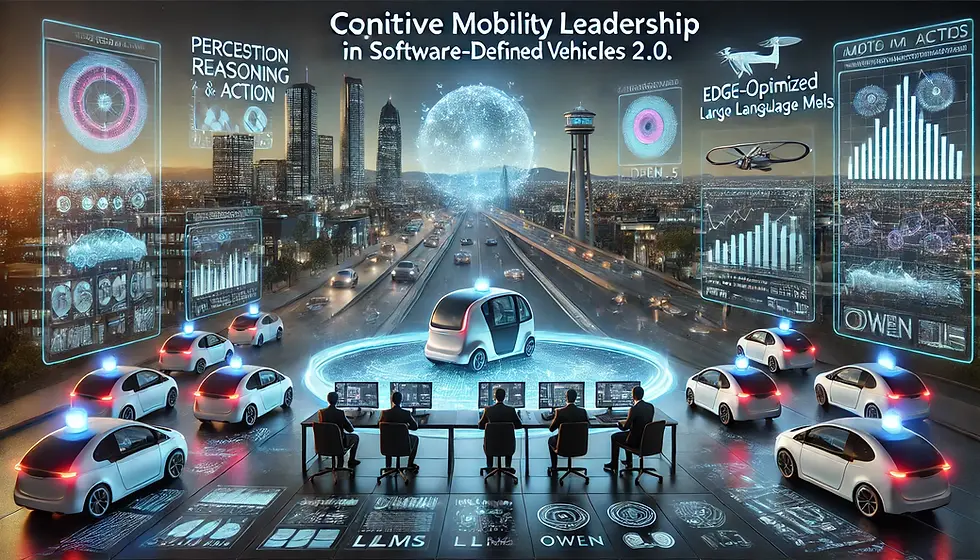Driving the Future: How Software-Defined Vehicles Are Revolutionizing Global Mobility (State-of-the-Art in 2024) - Part 1
- Mahbubul Alam

- Dec 16, 2024
- 4 min read

December 16, 2024
Introduction
The automotive world is at a turning point, driven by the emergence of Software-Defined Vehicles (SDVs). These vehicles are no longer static hardware machines but have evolved into software-powered platforms capable of adapting and upgrading with ease. As we navigate through 2024, SDVs are transforming mobility, reshaping premium innovation hubs in Europe, scaling affordable electric ecosystems in China, democratizing access to technology in India, and leveraging advanced cloud and AI solutions in the United States.
This article explores the state-of-the-art features of SDVs in 2024, highlighting how automakers and regions are shaping this transformation. From over-the-air (OTA) updates to the integration of artificial intelligence (AI), SDVs are enabling a convergence of software, data, and connectivity, offering new ways to address global challenges in transportation.
State-of-the-Art in 2024
Major Original Equipment Manufacturers (OEMs) and new entrants are adopting SDVs to redefine user experiences and business models. Some of the leading examples include:
Tesla: Innovating with OTA updates that introduce Full Self-Driving (FSD) capabilities and enhanced features without hardware upgrades.Volkswagen: Leveraging its VW.OS platform to offer monetizable features like dynamic light assistance and autonomous driving.Ford: Advancing with the Ford BlueCruise hands-free driving system, creating continuous revenue streams through software updates.BYD and Nio: Pioneering in embedded apps, AI-driven personalization, and vehicle-to-grid (V2G) integration.Key advancements in 2024 include dynamic OTA capabilities, AI-powered personalization, and robust ecosystems formed through partnerships with tech giants. Business models are shifting, as OEMs monetize features through subscriptions, third-party ecosystems, and data-driven services like fleet management
This bar chart visually represents the state-of-the-art features in Software-Defined Vehicles (SDVs) for 2024, highlighting key areas such as OTA updates, AI-powered personalization, in-car marketplaces, autonomous driving, and ecosystem collaboration.
SWOT Positioning of SDVs by Region
United States: The US leads in technological innovation with companies like Tesla and Rivian spearheading advancements in software-driven mobility. Its strong cloud infrastructure and partnerships with AI providers make it a key player in the SDV ecosystem. However, legacy automakers face challenges in transitioning from hardware-centric models to agile software development. The US has a significant opportunity to lead in autonomous fleet operations and ride-sharing markets, but regulatory hurdles and global competition pose ongoing threats.
Europe: Renowned for engineering excellence, Europe has a competitive edge in sustainable and premium SDVs. Countries like Germany and Sweden are home to legacy automakers investing heavily in eco-friendly designs and autonomous technologies. However, fragmented digital infrastructure and slower OTA adoption hinder progress. Europe’s focus on sustainability provides a unique opportunity to cater to environmentally conscious consumers, but the region risks losing market share to more agile players from the US and China.
China: China’s dominance in EV manufacturing and battery technology positions it as a frontrunner in SDV adoption. With swift government support and a robust domestic market, Chinese automakers like BYD and Nio are integrating advanced AI and vehicle-to-grid (V2G) technologies. However, over-reliance on domestic markets and limited global brand recognition are key weaknesses. Opportunities lie in AI innovation and competitive pricing, but geopolitical tensions and data privacy concerns pose significant threats to global expansion.
India: India’s large pool of software talent and cost-effective production capabilities make it a promising market for SDVs. The country has a growing middle class and rising demand for urban mobility solutions, which aligns well with affordable and purpose-built SDVs. However, limited EV infrastructure and low penetration of advanced SDVs are major hurdles. India can emerge as a hub for affordable SDV innovation, catering to both domestic and neighboring emerging markets, but it must address regulatory and standardization challenges to compete globally.
Here is the diagram illustrating the SWOT positioning of Software-Defined Vehicles (SDVs) by region, covering the United States, Europe, China, and India. Each region's strengths, weaknesses, opportunities, and threats are visualized on a scale of 1 to 5, providing a comparative view of their standing in the global SDV landscape.
The SWOT analysis reveals that each region brings unique strengths to the SDV race, while also grappling with challenges that could define their future trajectory. The US and China are well-positioned to lead in technology and scalability, respectively, while Europe and India offer potential in premium sustainability and affordable innovation. By understanding these regional dynamics, automakers can better align their strategies with local market needs, creating opportunities for collaboration and growth.
Conclusion
The state-of-the-art in SDVs for 2024 showcases the automotive industry’s ability to innovate and adapt to a software-first paradigm. From dynamic OTA updates to AI-powered personalization, SDVs are redefining mobility while reshaping business models through new revenue streams. Regional leaders are leveraging their strengths to create differentiated offerings, but the future of SDVs will require overcoming barriers in infrastructure, affordability, and regulation. In Part 2, we will delve into the predictions for 2025 and explore actionable strategies for automakers and policymakers to unlock the full potential of this transformative technology. Stay tuned for insights into how the SDV landscape will evolve and create new opportunities for global mobility.
Stay tuned for Part 2, where we explore predictions for SDVs in 2025 and offer strategic recommendations tailored to each region.#SoftwareDefinedVehicles #AutomotiveInnovation #MobilityTech #AIinAutomotive #ConnectedCars #EVRevolution #AutonomousVehicles #FutureOfMobility #DigitalTransformation #Sustainability #GlobalMobility #SmartVehicles #AIandCloud #EmergingMarkets #SWOTAnalysis #USInnovation #EuropeMobility #ChinaAutomotive #IndiaInnovation SmartAvatar B.V.



Comentarii